![]()
![]()
![]()
Use LEFT and RIGHT arrow keys to navigate between flashcards;
Use UP and DOWN arrow keys to flip the card;
H to show hint;
A reads text to speech;
84 Cards in this Set
- Front
- Back
|
What is Microbiology |
-study of organisms too small to be clearly seen by the unaided eye -these organisms are relatively small in their construction and lack organelles, highly differentiated cells and distinct tissues |
|
|
The Importance of Microorganisms |
-most populous group of organisms and are found everywhere on the planet. -Major bacteria living on you than your cells -Play a major role in recycling essential elements -fixing nitrogen for plants -source of nutrients and some carry out photosynthesis -benefit society by their production of food, beverages, antibiotics and vitamins |
|
|
Prokaryotic Cells |
-comparing Prokaryotic and Eukaryotic Cells -Prokaryotic comes from Greek word for prenucleus -DO NOT HAVE A NUCLEUS -Eukaryote comes from the Greek word for true nucleus
|
|
|
Members of the Microbial World |
-prokaryotic cells lake a true membrane-delimited nucleus= separate compartment inside the cell -eukaryotic cells have a membrane-enclosed nucleus, a more complex morphologically and are usually larger than prokaryotic cells -NOT separated from the rest of the cell |
|
|
Prokaryote vs Eukaryote |
Eukaryote -Paired chromosomes in nuclear membrane (two chromosome) -46 all together(missing chromosome=disorder) -Histones=Proteins -small protein -made out of amino acids(90-120 -bind and organize DNA -same in all living organisms -Organelles -Polysaccharide cell walls(cellulose) -animals do not have cell walls; plants do -Mitotic spindle -mitosis |
|
|
Prokaryote |
Prokaryote -One circular chromosome not in a membrane (more than one=a copy; usually 1 chromosome ) -No histones -No organelles(separate the rest of the membrane) -Do not have the membrane in bacterial Cell -Peptidoglycan cell walls -all bacteria have cell walls -Binary Fission -grow then split into two |
|
|
Viruses |
-Aceullular (NOT CELLS) -smallest of microbes -Cause a range of diseases including some cancers |
|
|
Naming and Classifying Microorganisms |
-Linnaeus established the system of scientific nomenclature -Genus and Species -Each Organism has two names: the genus and specific epithet |
|
|
Scientific Names |
-are italicized or underlined. The genus is capitalized and the specific epithet is lower case -are "latinized" and used worldwide -May be descriptive or honor of scientist -ran out of Latin words
|
|
|
Examples |
-Staphylococcus aureus (MRSA) -describes the clustered arrangement of the cells (staphylo-) and the golden color of the colonies -Hosptial -Escherichia coli (E. Coli) -Honors the discoverer, Theodor Escherich, and described the bacterium's habitat, the large intestine or colon *MRSA and E. Coli are found in the human body *MRSA is on the skin and E. Coli in the large intestine |
|
|
Classification of Microorganisms |
-Three Domains 1. Bacteria > Prokaryotes (used to be grouped together) 2. Archaea 3. Eukarya -Protists -Fungi -Plants -Animals |
|
|
Bacteria |
-Prokaryote -Peptidoglycan cell walls -Binary Fission -For energy, use organic chemicals, inorganic chemicals or photosynthesis -eat organic chemicals (carbon) we can
|
|
|
Archaea |
-Prokaryotic -Lack Peptidoglycan -Live in extreme environments -Include: -Methanogens (high methane concentration) -Extreme Halophiles (Lake or salty marshes) -Extreme thermophiles (deep sea vents) |
|
|
Fungi |
-Eukaryotes -Chitin cell walls -Use organic chemicals for energy -mold and mushroom are multicellular consisting of masses of mycelia, which are composed of filaments called hyphae -Yeasts are unicellular *Sporangia=used in bio-terrorism |
|
|
Protozoa |
-Eukaryotes -Absorb or ingest organic chemicals -May be motile via pseudopods, cilia, or flagella *Celia and Flagella *Ameba |
|
|
Algae |
-Eukaryotes -Cellulose cell walls -use photosynthesis for energy -produce molecular oxygen and organic compouns
|
|
|
Viruses |
-Acellular(NOT CELLS) -do not fit in three domain because do no have cells -Contain DNA OR RNA in core -one or the other *OR* (DO NOT have both) -Core is surrounded by a protein coat -core is where we find DNA or RNA surrounded by protein coat -very simple -Coat may be enclosed in a lipid envelope -some (3 out of 4) have a lipid envelope (membrane) *viruses are very mechanical -+++
|
|
|
Multicellular Animal Parasites |
-Eukaryote -Multicellular animals -Parasitic flatworms and round worm are called helminths -microscopic stages in life cycles *cause diseases in humans -mostly third world countries |
|
|
The First Observations |
a. Robert Hooke reported that living things were composed of little boxes or cells. -everything is make up of cells. b. Robert Virchow said cells arise from preexisting cells -biogenesis= cells comes from cells c. Cell Theory. All living thins are composed of cells and come from preexisting cells -both parts -spontaneous generation |
|
|
Microbes in Our Lives |
a. microorganisms are organisms that are too small to be seen with the unaided eye b. All cells are too small: why Micro? -would be very thin if they got so long; do not get big -would not be able to absorb nutrients from the environment and get rid of waste to function the most basic level if too large |
|
|
Attributes of Cells |
a. cell size -s/v ratio changes a small cell to a large cell b. why is there a limit to cell size? -Surface-to-Volume(S/V) ratio -Distance from surface to center |
|
|
Surface Area vs. Volume |
a. Why is surface area regular to its volume? -volume increases more rapidly than surface area -diffusion gets waste out; this needs a lot of surface area b. When cells get bigger, the surface area does not increase as much -larger animals have less surface area compared to volume to keep them warm -lower surface to volume ratio verses the surface volume ratio of a smaller cell |
|
|
First Observations |
Antoni van Leewenhoek described live microorganisms that he observed in teeth scrapings, rain water, and peppercorn infusions -Antoni was the first scientists to draw microorganisms correctly/accurately |
|
|
Discovery of Microorganisms |
a. Antoni van Leewuenhoek was the first person to observe and describe microorganisms accurately -invented the microscope |
|
|
The Debate over Spontaneous Generation |
a. the hypothesis that living organisms arise form nonliving matter is called spontaneous generation. According to spontaneous generation, a "vital force" Forms life -"vital force"= nonliving matter (decaying matter) could create living organisms b. The Alternative hypothesis, that the living organisms arise from preexisting life, is called biogenesis -Cell theory= biogenesis |
|
|
The Conflict over Spontaneous Generation |
a. spontaneous generation -living organisms can develop from nonliving or decomposing matter b. Francesco Redi -disproved spontaneous generation for large animals -showed that maggots on decaying meat came from fly eggs
|
|
|
John Needham |
-boiled broth to see if living microorganisms would be destroyed -broth became cloudy and contained microorganisms -FLAWED: we know that organisms can live in high temperatures like boiling water |
|
|
Lazzaro Spallananzi |
-sealed the broth then boiled broth to prove there no living microorganisms -No growth -FLAWED: contaminated experiment by sealing it. Life force cannot get it |
|
|
Louis Pasteur |
-placed nutrient solution in flasks -created flasks with long, curved necks -boiled solutions -left flasks exposed to air -results: no growth of microorganisms |
|
|
The Theory of Biogenesis |
-Pastuer's S-Shaped flask kept microbes out but let air in |
|
|
Final Blow to theory of Spontaneous Generation |
a. John Tyndall -Bacteria lives on dust and water particles -showed that if dust was absent, nutrient broths remained sterile, even if directly exposed to air -also provided evidence for the existence of exceptionally heat-resistant forms of bacteria (spores-heat resistant) |
|
|
Prokaryotic Cells |
-Basic Shapes: 1. Cocci's (OOO) 2. Rods/Bacilli (oval) 3. Spirilla -Unusual Shapes -Star-shaped Stella -Square Haloarcula -Most bacteria are monomorphic -always the same shape (one shape) -A few are pleomorphic -different life stages |
|
|
Arrangements |
a. Pairs: diplococcic, diplobacilli -chains of rods/bacilli b. Clusters: staphlococci -looks like grapes c. Chains: streptococci, streptobacilli -chains of round ones |
|
|
Gram Positive Rod |
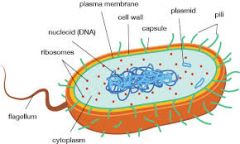
-Chromosomal DNA: purple ribbon -Nucleoid: region of the cell where we find the chromosomal DNA -Cytoplasm: substance inside the plasma -Plasma Membrane -Ribosomes: small particles that are made out of :protein and rRNA -Inclusion: solid forms of molecules that cells want to have in reserve -Plasma Membrne: first layer -Cell Wall: second layer -Capsule: last layer |
|
|
Cytoplasm |
-substance inside the plasma -collection of molecules in the cytoplasm: 1. Water 2. Nutrients (molecules to use as energy) 3. Nucleotides (building blocks of DNA + RNA) 4. Amino acids (building blocks of protein) 5 ATP 9use of energy to drive the processes) -Nucleoid: area or region of the cell where most DNA is found -Chromosome: DNA and associated proteins -DNA molecule: double stranded circular deoxyribonucleic acid -Genome: entire collection of genes the organism has; more found on chromosomal DNA |
|
|
Reproduction in Prokaryotes |
a.bacterium about to divide (binary fission) -Prokaryotic cells reproduce by a simple form of cell division called binary fission. b. Plasmid: small circular double stranded DNA with a few genes that an replicate independently. THEY ARE NOT ALIVE -Three Major plasmids: 1. R-plasmid (resistance)-protects bacteria from anitbiotics/drug 2. Toxin Plasmids: genes on plasmid allows bacteria to make cell poisons (toxins) 3. F-plasmids (fertility)- process conjugation (transfer genetic material:DNA) of one bacterium to another bacterium of the same generation
|
|
|
DNA and RNA structures |
-strands of DNA; Single strand of RNA -Naming the Carbons (numbers) -number of carbons in the sugar -have to be able to know the parts: -Phosphate: "P" -Base: nitrogen in it -Sugar -Pentose (5-Carbon) -Rules: 1. Number the carbons where the base is attached 2. Find the ring then go clockwise around the ring -number 5 carbon attached to phosphate group -number 3 carbon (3 prime OH) attached to hydrogen+oxygen *difference between Pentose Sugar RNA and DNA -NO oxygen attached to the 2 carbon on DNA -Base attached to 1st carbon -NO OH and Thymine=DNA -these atoms are found with individual nucleotides -However, they are removed when nucleotides join together to make strands of DNA or RNA |
|
|
Plasma Membrane |
-Gram Negative and Gram Positive -innermost layer=plasma membrane -all cell membranes always have this basic structure/similar function -Phospholipid -yellow ball -all cells have them -Peripheral proteins -inside force/outside force
-Polar vs. Non Polar
|
|
|
Transmembrane proteins |
-cross the membrane -expand from the outside to inside |
|
|
Polar vs NonPolar |
-Phosphate groups=Polar -outside layer -one side of the molecule is negative; other side is positive -H20 -Lipids=Nonpolar -inner layer -fat part -legs on the phospholipid do not like water -Hydrophobic/hydrophilic -holds the cell together |
|
|
Plasma Membrane Diagram |
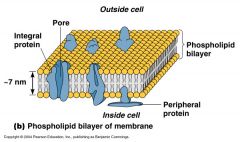
|
|
|
Fluid Mosaic Model |
-membrane is a viscous as olive oil -moves; does not move at a fast pace -Proteins move to function -flow around in the phospholipid membrane -phosphates can move laterally, but cannot move from one layer to another polar head would have to go through a nonpolar area -membrane= gate keeper of the cell -controls what comes into the cell and what leaves the cell -Phospholipids rotate and move laterally |
|
|
Cell Wall |
-prevents osmotic lysis -gives the cell structure; backbone; cells shape -made of peptidoglycan (in bacteria) -cell wall has gaping holes so stuff easily passes through it |
|
|
Peptidoglycan |
-Polymer of disaccharide -polymer: really big and they are repeating -attached together -Linked by polypeptide chains |
|
|
Gram Positive Cell Walls |
-Teichoic acids: -Lipoteichoic acid links to plasma membrane -Wall teichoic acid links to peptidoglycan
|
|
|
Gram Negative Outer Membrane |
-thinner cell wall- no peptidoglycan -NO teichoic acid/lip teichoic acid -outer membrane=gram negative -forms the periplasm between the outer membrane and the plasma membrane -Porins form channels through membrane |
|
|
Porin Protein |
-Transmembrane protein -only in outer membrane=gram negative -"pore": wide opened -porous membrane -not selective/stuff easily moves through |
|
|
LPS (lipopolysaccharide)/endotoxin
|
-lipid part toxic to some of our cells -periplasmic is the space where the solution of the enzymes are trapped in between the two membranes
|
|
|
Protection from Phagocytes, complement, antibiotics |
-outer membrane protects gram negatives more than gran positives for our immune system |
|
|
What to Know: |
Gram Positive Gram Negative -Thick peptidoglycan (cell wall) -Thin peptidoglycan (cell wall) -Lipoteichoic and teichoic acids -No teichoic and lipoteichoic acids -Outer membrane -Porin protein |
|
|
Atypical Cell Walls |
-mycoplasms -lack cell walls -Sterols in plasma membrane -cholesterol -Archaea(prokaryotes; not bacteria) -wall-less or -walls of pseudomurein (lack NAM and D amino acids)
|
|
|
Glycocalyx (two types: capsule + slime layer) |
-ouside cell wall -usually sticky - a capsule is neatly organized -woven together -a slime layer is unorganized and loose -slime: oozes around the cell; no definite shape -Ex: bacteria sticking together -Extracellular polysaccharide allows cell to attach -polysaccharide: sticky, helps attach to things -Capsules prevent phagocytosis -helps prevent bacterium from white blood cells |
|
|
Flagella Arrangement(same location and number) |
-Monotrichous=one -Amphitrichous: two -Lophotrichous= group -Peritrichous: covered with flagellum/all over periphery
|
|
|
Example on Board |
-Experiment: -flagellum composed of a protein flagellum -use antibodies for flagellum -i.e. antibodies that bind only flagellu -Model -Rotate -Whipping -Contract/Elongate -use antibody as a tool -antibodies: proteins that bind to other molecules (antigens) that are foreign to the organism -bind the antigen with high specificity |
|
|
Motile Cekks |
-rotate flagella to run or tumble -flagella works by rotating -spin in both directions; clockwise + counterclockwise -Do NOT reverse -move toward or away from stimuli (taxis) -stimuli move toward= attractive -stimuli move away from= repellant -Chemotaxis: movement of a cell in response to a chemical gradient -all cells are possible to do chemotaxis |
|
|
Flagella |
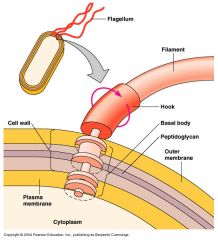
-outside cell wall -made of chains of flagellin -rigid structure -cork screw shape -attached to a protein hook -hook: flagellum forward and turns the other way when there is no productive movement -anchored to the wall and membrane by the basal body -structure: understand motor=basal body(how it turns) |
|
|
Motile Cells: Chemotaxis |
-two behaviors: 1. Run: move productively one way in a straight line 2. Tumble: stops and rotates around -when does a tumble stop and go back into a run? -rotate it back the right way -alternate between the two -run and tumble is the direction the flagellum is turning -when runs are in the right directions toward an attract, they are longer; wrong direction, they are shorter -Runs going in the right direction, they are less likely interrupted by a tumble; runs in the wrong direction, more likely to be interrupted by a tumble |
|
|
Recollection of Last Class |
-Chemotaxis: movement towards things -Run: straight lines -Runs in right direction= longer distance -Why doesn't it stay in straight line? -attractant is moving too -always changing |
|
|
Axial Filaments (endoflagellum) |
-Endoflagella -flagellum embedded in envelope -causes the rotation of the cell -in spirochetes -anchored at one end of a cell -rotation causes cell movement |
|
|
Fimbrae |
-allows attachment -allows bacterial to stick to surfaces -NOT the same to Cilia *just for attachment* |
|
|
Conjugation: Prokaryotic "Mating" |
-Pili are used to transfer DNA from one cell to another -Pilus: bridge between the two cells -made of protein called PILIN |
|
|
Spores/Endospores |
-bacterium -endospore= spore inside the cell (immature) |
|
|
Endospores |
-Resting cells (dormant cell): shuts down all activity and waits -completely shut down -Resistant to desiccation, heat, chemicals, radiation and time -Bacillus, Clostridium -Sporulation: endospore and spore formation -when conditions are bad (process of making endospore) -Germination: return to vegetative state -opposite of sporulation (become active again) -vegetative state: growing, active state |
|
|
Spores and Endospores of Bacteria |
-Why are they important? -Pathogenic spore formers: anthrax -Dormancy-Virtually Immortal: bacteria comes back to germ |
|
|
Examples of Endospore Location and Size |
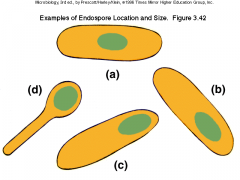
a. central endosperm b. subterminal endosperm c. terminal endosperm (near the end) d. Terminal with a bulb |
|
|
Mother-Cell/ Sporangium |
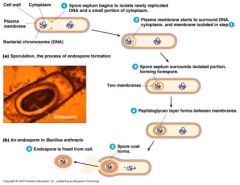
1. Bacterium about to make a spore -replicate DNA (chromosome) 2. Plasma membrane surrounds DNA 3. Spore surround 4. Cell wall forms 5. Spore coat forms (endospore is formed) 6. Endospore is now a spore |
|
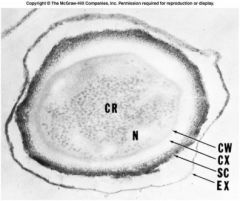
|
CR: center/core of ribosomes N: DNA of spore CW: Core Wall (peptidoglycan) CX: cortex (stability) SC: Spore coat (tough protein layer: protectant) EX: exosporium -polysaccharide (outermost layer made of sugar) *STICKY* |
|
|
Activation-Sub Germination-Outgrowth = Germination: Reverse Sporulation |
-3 major steps: 1. Activation -responds to nutrients in the environment by activating the DNA 2. Sub-Germination -take all parts activating and rebuild the whole vegetative cell 3. Outgrowth (hatching) -spore splits the spore coat open and now can go out into the environment and grow and divide again |
|
|
Eukaryotic Cells |
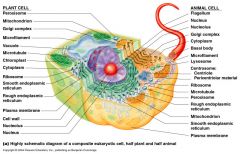
|
|
|
Nucleus |
-nucleus -surrounded by TWO membranes -punctuated with protein porins -Chromatic: substance (DNA + protein together) -nucleolus: -making rRNA (ribosomal RNA) and have rproteins -put these two together to make ribosomal subunits -*46 paired chromosomes: XX-female; XY: male
|
|
|
Endoplasmic Reticulum |
-just membrane -Cisterns=open/hallow part of the ER -all interconnected/continuous -RER: closest to the nucleus and has ribosomes stuck to it -SER: more distal from the nucleus and has no ribosomes stuck to it
*ribosomes make protein* *proteins move distal from RER to SER then proteins get modified in SER*
|
|
|
Golgi Apparatus |
-Lipid Bilayer -Series of flattened vesicles/membrane sacs=not connected;separate -Sorts and packages proteins, then sends out proteins to their proper destination (transfer vesicles) |
|
|
Mitochondria |
-two membranes -power house of the cell; synthesis of ATP (glucose+oxygen) -has its own genes that encodes most mitochondria proteins and ribosomes (70s) -binary fission: splits into two |
|
|
Endosymbiotic Theory |
-Mitochondria thought to be derived from bacterium -evidence: circumstantial (mitochondria has structures + behaviors that are not found anywhere else except for in bacteria, not eukaryote) -two membranes (Gram -) -DNA: has its own chromosome that is circular -genes to make mitochondrial proteins -Ribosomes: has its own ribosomes to make proteins(70s) -Replicates DNA(like a cell) and divides by binary fission(only seen in bacterial
|
|
|
Flagella and Cilia |
-Some bacterial have flagella -Bacteria DO NOT have cilia; have fimbriae -Eukaryote: All cilia and flagella are made out of microtubules (protein called tubulin) -Movement: do not rotate; whip back and forth
|
|
|
Chart of Differences |
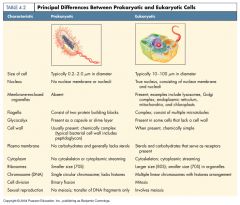
|
|
|
E.Coli |
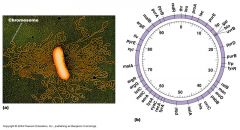
-DNA leaking out of the cell -macromolecule |
|
|
9.2 Nucleic Acid Structure |
-DNA and RNA are large macromolecules with several levels of structure 1. Nucleotides form repeating units -made out of nucleotides (4 parts) 2. Nucleotides are linked to form a strand -take nucleotides place into a long chain 3. Two strands can interact to form a double helix -take two strands stick them together to form a double helix 4. The double helix folds, bends and interacts with proteins resulting in in 3-D structures in the form of chromosomes -Put into chromosome |
|
|
Nucleoties (the most basic level) |
-the nucleotide is the repeating structural unit of DNA and RNA -polymers(repeating units of a long chain)= DNA,RNA and protein -Three parts: 1. A phosphate group 2. A pentose sugar (5-carbon sugar) 3. A nitrogenous base (molecule contains nitrogen) -Recognize each group type -phosphate has phosphate group -sugars have no nitrogen -nitrogen has nitrogen *process of elimination |
|
|
Recognize each group type |
-phosphate has phosphate -sugars has no nitrogen -nitrogen has nitrogen *process of elimination |
|
|
DNA and RNA structures |
-Strands of DNA -Single strand of RNA |
|
|
Naming the Carbons(numbers) |
-number of carbons in the sugar -have to be able to know the parts -Phosphate: "P" -Base: nitrogen in it -Sugar |
|
|
Pentose (5-Carbon |
1. Rules a. number the carbons where the bases are attached b. find the ring then go clockwise around the ring -number 5 carbon attached to phosphate group -number 3 carbon (3 prime OH) attached to hydrogen and oxygen
|
|
|
Differences between Pentose sugar RNA and DNA |
-NO oxygen attached to the 2 carbon on DNA -base attached to 1st carbon -No OH and Thymine= DNA |

